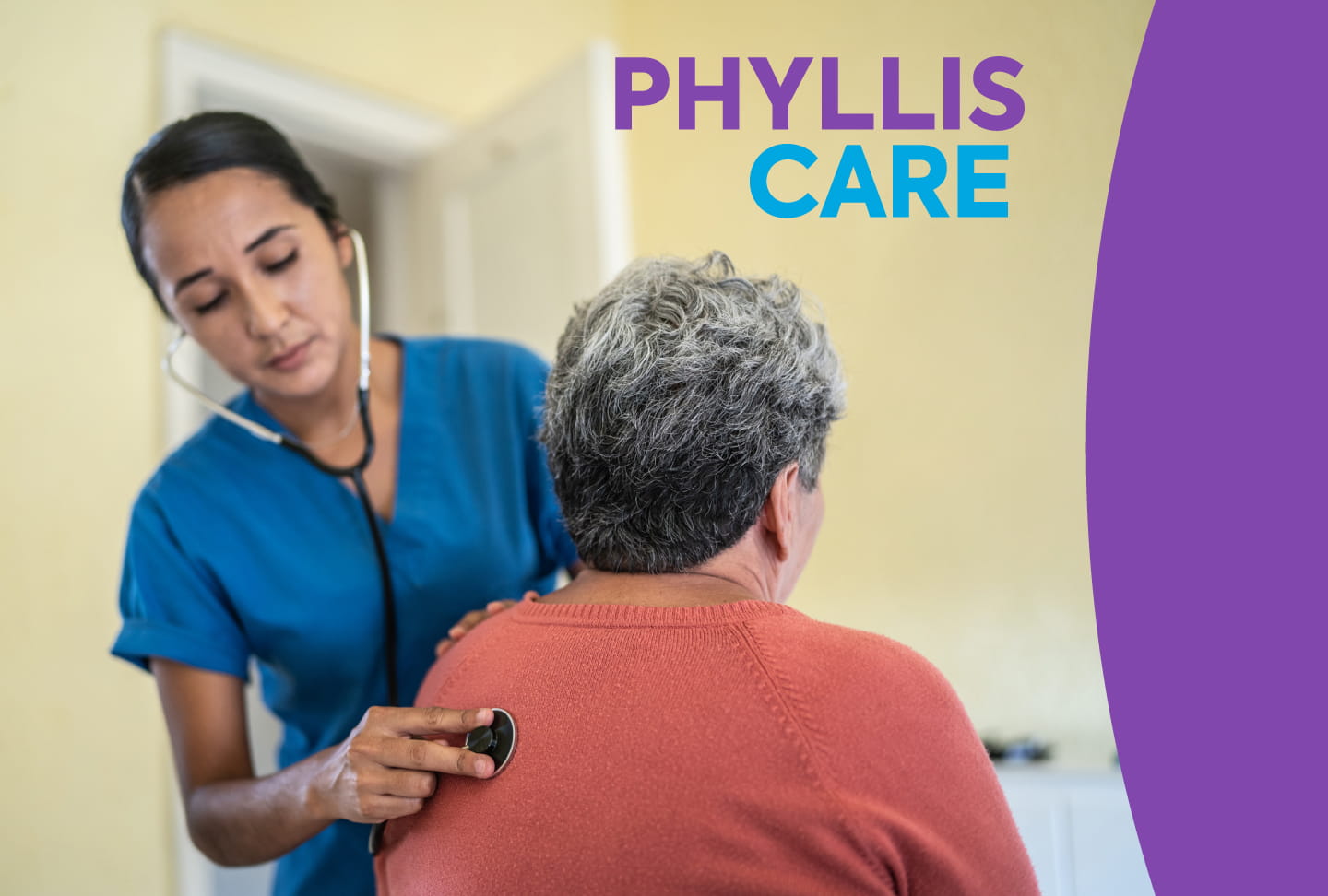
PhyllisCare
From screening to surgery with the Wellstar STAT Clinic for Lung Cancer
Published on May 27, 2025
Last updated 01:33 PM May 27, 2025


Cancers are so insidious. You’re not going to just go, 'Gee, I don’t feel good; it must be cancer.' There’s no big warning signs until it’s serious. Early detection is absolutely our best weapon. It’s our best defense.
- Phyllis Burgess
Lung Cancer Survivor
Tags
David Austin Gose Paulding Medical Center Daniel Leite Cardoso FortesPeopleCare Cancer Care
Related Articles

PeopleCare
EricCare
Eric Janeau, a former All-American offensive tackle who once played football at Kansas State University and Western Illinois University and trained with the Detroit Lions, faced a host of serious health conditions—a rare form of bile duct cancer, obesity, heart failure, kidney disease and diabetes. With the support of his tight-knit network of doctors and the Wellstar Center for Best Health, Eric is overcoming these obstacles and inspiring others through his remarkable weight loss journey.
Life change kickoff: A rare cancer diagnosis
In 2021, Eric was diagnosed with a rare and aggressive bile duct cancer.
“I was in disbelief,” Eric remembered. “I didn’t eat all weekend.”
The only cure was surgery, but at 11 centimeters, the tumor was too large to be removed. Under the care of Medical Oncologist Dr. Carmen Klass, Eric began chemotherapy. At the time, he didn’t realize just how dismal his chances were for survival. At stage 4, the survival rate for this cancer type is 1%, with only four to six months to live if treatment isn’t successful.
Eric began chemotherapy accompanied by additional hydration to help with his heart failure and steroid shots that caused him to gain weight during treatment. After 12 rounds and six cycles of chemo, his body responded excellently—the mass shrunk by 40%. Surgical Oncologist Dr. Sahir Shroff re-evaluated him and cleared him for surgery to remove the tumor in early 2022.
Today, Eric is cancer free.
One team, one goal: Eric’s health comeback
Eric’s journey didn’t end with cancer treatment. He also faced severe obesity, putting him at risk for life-threatening conditions like heart disease and stroke. Dr. Klass was concerned and took the time to address Eric’s other health concerns.
“Dr. Klass and Dr. Shroff keep up with my health and they keep each other informed of what’s going on,” Eric said. “They're totally invested in my well-being.”
After chemotherapy and surgery to remove the tumor, Dr. Klass referred Eric to Dr. Mitzi Rubin at Wellstar Center for Best Health. It was time to lose weight and get his diabetes and high blood pressure in check.

Highlights
One-Stop Treatment Clinic for Patients with Thoracic Cancer
If you had to guess which cancer took the most lives in America, what would your guess be?
“Lung cancer is the No. 1 cancer killer in the U.S. for both women and men since 1986,” said Dr. Daniel Miller. Dr. Miller is the chief of thoracic surgery and the director of the Wellstar Georgia Cancer Center lung cancer screening program.
About 80% of lung cancer cases are associated with cigarette smoking, including secondhand smoke. Unfortunately, when symptoms begin showing, the cancer has already spread, making treatment very time-sensitive. When a patient is diagnosed, their care team typically includes not just one, but four doctors: a thoracic surgeon, an interventional pulmonologist, a medical oncologist and a radiation oncologist. There are many benefits to having a large care team, but a huge drawback can be the wait time between appointments with each doctor.
“When you have cancer, you want to be seen now and be treated now,” Dr. Miller said.
The speed of treatment time for patients is what inspired the creation of the Thoracic-Oncology NOW (New Oncology Workgroup) Clinic at Wellstar Georgia Cancer Center. The multidisciplinary clinic is staffed by specialized physicians in the treatment of thoracic malignancies.
The clinic treats not just lung cancer, but also esophageal cancer, metastatic disease to the lungs and malignant pleural effusions.
“You’re cutting back on treatment time, waiting time, travel time and, more importantly, you have a group of doctors, rather than a doctor, who are talking about your care,” said Hematologist and Oncologist Dr. Girinda Raval.
The clinic operates on Wednesdays and acts as a one-stop shop for patients, saving their time and the time of their loved ones who join them for treatments. Patients also have access to Wellstar Georgia Cancer Center’s registered dietitians and social workers, along with a scheduler, financial personnel and medical assistants, creating one large care team ready to help them on their treatment journey.
“There is a degree of reassurance for the patient that there is a team who are all engrossed in caring for that patient,” Dr. Raval said.
To learn more about the Thoracic-Oncology NOW Clinic or make an appointment, call (706) 721-6744 for more information.

PeopleCare
KathyCare
Kathy DeJoseph delights in making and giving away thousands of soft and cheerful hats to Wellstar cancer patients through a nonprofit she founded called Happy Caps. It’s all in the name of bringing a little light and comfort to people during a hard time.
Where did the idea come from? It started with Kathy’s own lung cancer diagnosis.
A commitment to yearly lung cancer screening
A cancer survivor for more than a decade, Kathy said regular lung cancer screenings were the key to her survival. With a long history of smoking and growing up around relatives who smoked, she decided to join an early detection lung cancer study at Wellstar.
Even though she felt fine and had no symptoms, committing to the study meant having an annual low-dose CT scan every year. After several years of clean scans with no signs of lung cancer, Kathy told a nurse that she was going to quit. But the nurse persuaded her to come in for another screening.
“Thank goodness she did,” Kathy said. “I was diagnosed the very next day.”
Quick and efficient treatment at the STAT Clinic
Being a part of the study and getting screened early allowed Kathy to move immediately to Wellstar Lung Cancer STAT Clinic at Wellstar Kennestone Regional Medical Center.
STAT stands for Specialty Teams and Treatment, highlighting the collaboration of multiple cancer experts. Together, they come to a consensus on a treatment plan and meet with the patient on the same day. This puts the patients at the center of their care plan, allowing them and their families to get immediate answers to questions, make decisions and start treatment faster.
“The biggest benefit for me with the way the STAT Clinic works is that I didn’t have to worry about whether the doctors had actually talked to each other,” Kathy said. “They’d come in one after another and tell me what they thought from their expertise.”
Immediate communication and mutual agreement among medical experts mean treatment plans are established and started faster, which is proven to improve long-term survival. On average, it takes 60 to 90 days from the time of diagnosis to treatment in the U.S. With the STAT Clinic at Wellstar, patients go from diagnosis to treatment in 14 to 20 days.
Kathy’s treatment started quickly—she had a lung biopsy the day after her STAT Clinic appointment and started chemotherapy a week later.
“I wasn’t as terrified for as long as most people are because I had answers within a short period of time,” Kathy remembered.
She had surgery once she completed chemotherapy. Throughout the process, she had the support of an entire cancer team, including a medical oncologist, a lung cancer surgeon, a pulmonologist and a nurse navigator.
We use cookies for booking and general analytics. Learn more about or internet privacy policy.
